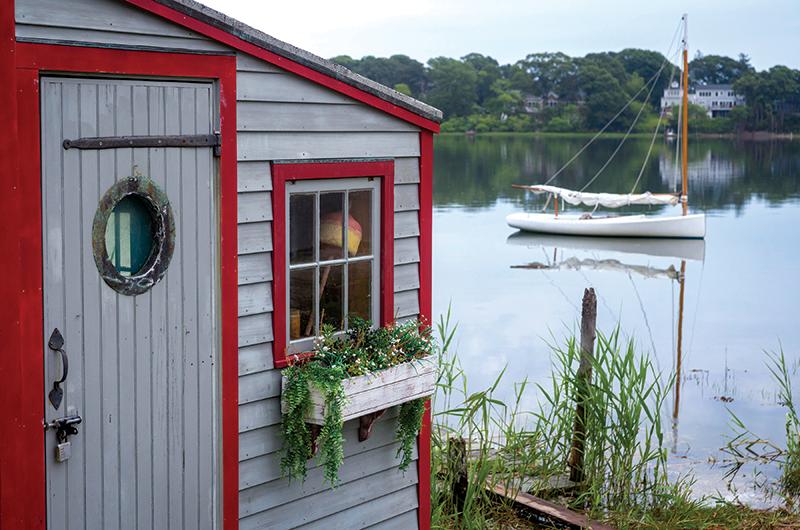Architect-designed and custom-built, or a backyard project festooned with deer antlers, Martha’s Vineyard sheds are a favorite and common hallmark of the Island lifestyle.
Typically, a shed is a place for backyard equipment and recreational gear. Often, it’s where a homeowner puts stuff he or she just doesn’t know what to do with and hopes will in time disappear by spontaneous happenstance. Thus rewarded by its eventual miraculous absence, the junk-keeper will not need to decipher town regs and landfill schedules to get rid of it.
The rare Island shed in which there is still plenty of storage space suggests the homeowner just moved to Martha’s Vineyard or has no children or Island friends. Not to mention the kind of summer friends who wonder if they can store a bike or a kayak there for the eleven and a half months they are not on-Island. Asked what’s in his shed, Tom Robinson of Vineyard Haven said, “A broken lawn mower, old flower pots I plan to take to the dump someday, and stuff I don’t want anymore…oh, and I have your ladder.”
For some Islanders, one shed is not enough. “I’ve got a tool shed, I’ve got a nail shed, and I’ve got a garden shed,” builder and caretaker Joe Canha of Vineyard Haven explained. “My hunting equipment and tree stands usually go in my old chicken coop. That’s the one I call my nail shed.”

No matter how much shed space is available, there are some items that belong in every Island shed. First and foremost is a quality long-handled clam rake. It’s a good idea to have extra rakes on hand for house guests who will want to share several hours spent on a tidal flat gathering littlenecks, cherrystones, and chowders (they are all the same clam just differentiated by size) for dinner.
Avoid a rake that has a flimsy basket attached with clips that will quickly rust and fall off. A KB White basket rake, available at Island tackle shops, may be more expensive, but it will last for years and add evidence of shellfishing expertise, even if it only hangs on the side of the shed all season.
Invest in a half-bushel galvanized metal basket with a float. That size is the weekly recreational limit and is more than enough clams to make an impressive chowder.
And there is no reason to limit shellfishing activity to the summer months, but you will need to make room in the shed for a pair of inexpensive boot-foot neoprene waders. A pair of heavy socks and long underwear will keep you comfortable enough to rake clams on a bright winter day. The waders will also come in handy when the fish arrive in the spring and the water remains cool.
Caretaker Ned Casey of Edgartown looks after several luxurious houses in Katama. Asked about the contents of sheds, Casey laughed and said, “They don’t have sheds. They have me.” But this experienced man-Friday added that the essentials of any seasonal shed include bicycles, bike tire pumps, and boat gear.
Not every shed is utilitarian or built simply to hold stuff. Some are designed to hold ideas.
When South Mountain Company in West Tisbury built and donated a shed to the “Houses on the Move” affordable housing fundraiser, CEO John Abrams left a letter for the new owner in which he described the inspiration for the meticulously constructed shed built with Island materials. He said it was initially envisioned as a Menemsha fishing shack, but, as the design developed, it became a writer’s shack, “a little getaway that seems to belong in a small clearing at the end of a shady path in the woods, or at the edge of a field looking toward the water.”
Abrams said sheds, like outdoor showers, are part of the Island landscape. What’s in his shed? “Outside tools and bicycles and feed – feed for ponies that haven’t been there for a few years but the feed’s still there.”
Architect Phil Regan, a partner in Hutker Associates, said he finds a lot to like in the word “shed.” “That sounds more architecturally interesting to me than, say, ‘pool house,’ for instance.”
At its most basic, a shed is a simple structure with a pitched roof or, he said, citing the work of Island stonemason Lew French, “quite a piece of art constructed of stone.”
Because building a shed does not require the resources of a big contractor, Regan said, “If you have some time on your hands you can probably construct something that will be very personal.”
Years ago, my wife and I bought a small, shingled shed built by students in the carpentry program at the Martha’s Vineyard Regional High School. The available space is taken up by deer stands, waterfowl decoys, a bag of solidified pelletized lime I promised to spread years ago, a set of tiki torches not lit in years, and lawn and house flotsam and jetsam.
Carpentry teacher William Seabourne said the shed building program showcases the skills of his students and provides a community service – sheds are given to other Island schools or nonprofits. He said the students make fewer sheds then they did in the past, but on occasion, an extra one is sold to support the program.
“Strangely enough, I have probably built close to 150 sheds on the Island, and I don’t own one myself,” Seabourne said. “Maybe one of these days I will build one and rescue the mower and bikes that are scattered in the yard.”




